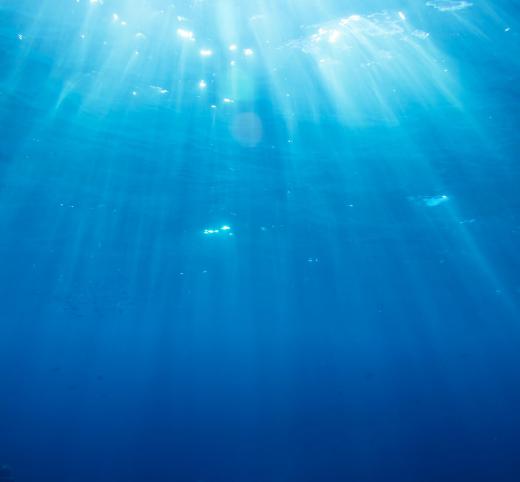In Marine Biology, what is the Difference Between the Photic and Aphotic Zones?
 Michael Anissimov
Michael Anissimov
The photic zone refers to the portion of the water column in a lake, sea, or ocean that receives light, while the aphotic zone is the part of the water that doesn't. Because light is required to photosynthesize, a body of water's primary productivity (the amount of biomass generated directly by the sun's energy) is directly proportional to the size of the aphotic zone. Formally, this zone begins where less than 1% of light penetrates.
In the ocean especially, the portion of the water that doesn't get any light is a very deep area. It extends from 3,000 - 15,000 feet (0.9 - 4.6 km) in depth. A variety of unusual animals live here, including the giant squid, vampire squid, gulper eel, angler fish, and many others. Quite a few animals in this zone are bioluminescent, which means that they are capable of generating their own light.

Where the aphotic zone begins depends on the number of particles suspended in the water, a quality called turbidity. It ranges significantly based on the season, whether it has rained recently, the type and location of the body of water, and other factors. Turbidity can be roughly measured by a simple device called a Secchi disk, which consists of a disk covered in an alternating black and white pattern. The disk is put on a rod and lowered into the water. The point at which the pattern becomes impossible to see tells the viewer roughly how turbid the water is. For a more accurate measurement, a device called a nephelometer is used.

In the world's oceans, the aphotic zones are relatively deserted in comparison to the photic zones. As a comparison, a person can imagine taking a gigantic sunshade and using it to enclose everything in a patch of forest — eventually, most forms of life in the shaded part of the forest would die. In the oceans, however, detritus raining from above provides a source of food, so some life can survive. Other animals spend time in this zone, but ascend to the photic zone to feed.
AS FEATURED ON:
AS FEATURED ON:












Discussion Comments
@croydon - There is a theory that even life on Earth came from outer space and was brought here on space debris. If you follow that theory, it's not out of the question that in some deep space ocean somewhere there is life that evolved to take advantage of some other form of energy, like chemical or thermal energy that exists outside of a photic zone.
We know so little about our own aphotic zones it's ridiculous. They say we know more about the surface of the moon than the deep parts of our own ocean. There could be things down there that we can't even imagine.
@clintflint - It's possible for life to arise in any number of ways that doesn't rely on the sun for energy. But is it likely? You'd need an area where there was enough activity and energy to justify the creation of life. I doubt that the creatures that live by the vents evolved without any input from other ecosystems. It's more likely that they were originally powered by the sun and then gradually took advantage of the heat from the vents.
Plenty of creatures survive in the aphotic zone, but their survival can all be traced back to energy that comes from the sun.
There are other ways in which life can survive in aphotic zones. The most famous is the ecosystem that has formed around volcanic vents, living from the warmth and gases produced there.
The reason light is so important is because light from the sun is where the energy in almost every ecosystem comes from. Plants or algae use the energy from the sun to live and reproduce and other animals use energy from those plants and so forth.
So they didn't think anything could survive without the sun helping in some way, until they found those vents. And it's actually an amazing discovery, because it greatly expands the number of places in the universe where life might be found. The limiting factor of being close enough to an appropriate star might not be as stringent as scientists originally thought.
Post your comments